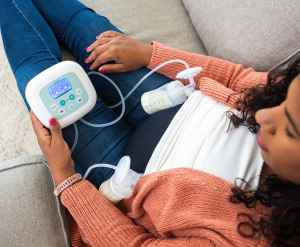Categories: Baby, Breastfeeding, Pumping
August 3, 2022
Feeding a baby, especially a newborn, is a journey. While it is a beautiful bonding experience, it can also be incredibly demanding and stressful. Some families who intend to breastfeed may encounter unexpected situations that lead to detours along the way. Triple feeding may be part of the plan to help reach breastfeeding/chestfeeding goals.
What is Triple Feeding?
Triple feeding is when there are three defined aspects of each individual feeding session for a baby:
- Direct nursing
- Supplementing
- Pumping
There are many reasons why triple feeding may be needed, such as:
- Refusal of the breast/chest
- Baby weight loss
- Painful latch
- Low milk supply
The child’s pediatrician and an IBCLC (International Board-Certified Lactation Consultant) should be consulted to determine if triple feeding is necessary.

Direct Nursing
Frequent and regular attempts at nursing can be considered the most important part of triple feeding. Triple feeding is not a long-term solution to feeding difficulties. It is a way to move beyond difficulties with the goal of getting to, or back to, exclusive nursing. Direct nursing is the first part of each feeding session. It may require aids such as SNS (supplemental nursing system). Direct nursing is incredibly important because it is where parent and baby learn about their latch and direct feeding. It also sends signal to the body that breastmilk is needed, therefore stimulating supply for the feeding parent.
How long to direct nurse or attempt to latch during each feeding session is different for each parent/child. Working with an IBCLC is incredibly helpful throughout this process to determine what is right for specific situations.
Supplementing
After an attempt at direct nursing, supplementation can be done with pumped breastmilk or formula. The wind down of supplementation should move from formula (if using), to pumped milk, to no longer needing to supplement at all. This can be done at the breast/chest directly with pumped milk during direct nursing, with a bottle, or through finger or cup feeding.

Pumping
How often to pump in a day, for how many minutes, and at what settings is defined by each individual’s situation. The best way to determine these factors is by connecting with an IBCLC. It may be most beneficial to pump with a double electric breast pump. This can save time and help stimulate more milk compared to single pumping or using a manual pump. Thankfully, many double electric breast pumps are covered by insurance. In addition to double pumping, breast massage or hands-on pumping can also be helpful for stimulation.
It is important to follow appropriate milk storage guidelines when pumping and feeding breastmilk to babies.
When To Stop Triple Feeding
There are several factors to consider before triple feeding ends. If baby improves at emptying the breast, milk supply is sufficient, and appropriate weight gain is continuous, then supplementation and pumping can slowly be reduced. All these factors can be confirmed by the pediatrician and IBCLC overseeing care.
Support Matters!
Before, during, and after everything stated above, anyone that will be triple feeding needs to ensure they have a support system in place. Having the right support system will help reduce stress. Less stress equals more chances for your body to produce oxytocin, one of the hormones responsible for milk production.
Examples of support that may be beneficial include prepared snacks, washing pump parts and bottles, changing diapers, and general home care. Triple feeding takes time and energy! Any support can make a tremendous impact.
For more information on how to support a lactating individual, read this article from the Le Leche League.
